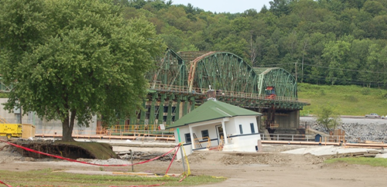The Mohawk River is both the largest tributary to the Hudson and, in the words of John Cronin, Director of the Beacon Institute, the neglected stepchild of the Hudson. Among the problems faced by the Mohawk River community, that has not been a recent issue in the Hudson Estuary, is flooding. A June, 2006 flood destroyed private and public property. It contributed to Beech-Nut, a major employer in Canajoharie, relocating. Floods are also a frequent occurrence in Schenectady due to ice jams.
 The Schenectady County Office of Emergency Management currently relies on observations from bridges of when ice jams are beginning. These can happen quickly and they usually occur at night when temperatures are lowest. High-frequency real-time water level monitoring could help the County warn residents of flood danger, evacuate people and animals, and help warn industries to shut down or move equipment. Brookfield Renewable Power, operator of a hydroelectric dam at Cohoes, is funding the US Geological Survey to install and operate an acoustic Doppler current profiler on the Freeman’s Bridge, in Schenectady. The NY Department of Environmental Conservation is looking into establishing a new HRECOS (Hudson River Environmental Conditions Observing System) station at Lock 8, just west of Schenectady. The plan is to provide Emergency Management with the calculated difference between stages at Lock 8 and Freeman’s Bridge. Rapid changes in the difference, observable anywhere by the internet, will give more timely information on rising waters. Meteorological data from the Lock 8 HRECOS station would be used by the National Weather Service to improve weather predictions in the Eastern Mohawk Valley. Additionally, Union College will install a night-vision web cam at their Schenectady boathouse so ice pile-ups and be seen.
The Schenectady County Office of Emergency Management currently relies on observations from bridges of when ice jams are beginning. These can happen quickly and they usually occur at night when temperatures are lowest. High-frequency real-time water level monitoring could help the County warn residents of flood danger, evacuate people and animals, and help warn industries to shut down or move equipment. Brookfield Renewable Power, operator of a hydroelectric dam at Cohoes, is funding the US Geological Survey to install and operate an acoustic Doppler current profiler on the Freeman’s Bridge, in Schenectady. The NY Department of Environmental Conservation is looking into establishing a new HRECOS (Hudson River Environmental Conditions Observing System) station at Lock 8, just west of Schenectady. The plan is to provide Emergency Management with the calculated difference between stages at Lock 8 and Freeman’s Bridge. Rapid changes in the difference, observable anywhere by the internet, will give more timely information on rising waters. Meteorological data from the Lock 8 HRECOS station would be used by the National Weather Service to improve weather predictions in the Eastern Mohawk Valley. Additionally, Union College will install a night-vision web cam at their Schenectady boathouse so ice pile-ups and be seen.
US Representative Paul Tonko’s staff assembled a group of interested people, the Mighty Waters Task Force, to help create a “climate of investment, recovery and public awareness for the waterways and communities of the upper Hudson and Mohawk Rivers, Erie Canal and related waterways by mobilizing federal resources that encourage policy reform, economic development, public access and enjoyment and effective environmental and cultural resource management.” Mighty Waters has six elements; 1) Environmental Quality and Infrastructure, 2) Recreation, Historic and Cultural Resources, 3) Education and Research, 4) Economic Development, 5) Regional Identity and Communication, and 6) Government and Policy.
Funding of this endeavor would raise the profile of this historic, beautiful, but neglected waterway and may provide expansion and collaboration opportunities for the Hudson River Estuary research community. HRES member Simon Litten submitted a proposal to the Mighty Waters Task Force to set up suspended sediment monitoring stations on Schoharie and West Canada Creeks.
On March 18 Union College, in Schenectady, will be hosting its third annual Mohawk Watershed Symposium. In the past these worthwhile symposia have brought together speakers on engineering, science, and public interest topics.
Prepared March 2, 2011 by Simon Litten, NYS DEC (retired). For questions or comments please contact Simon at This email address is being protected from spambots. You need JavaScript enabled to view it..

